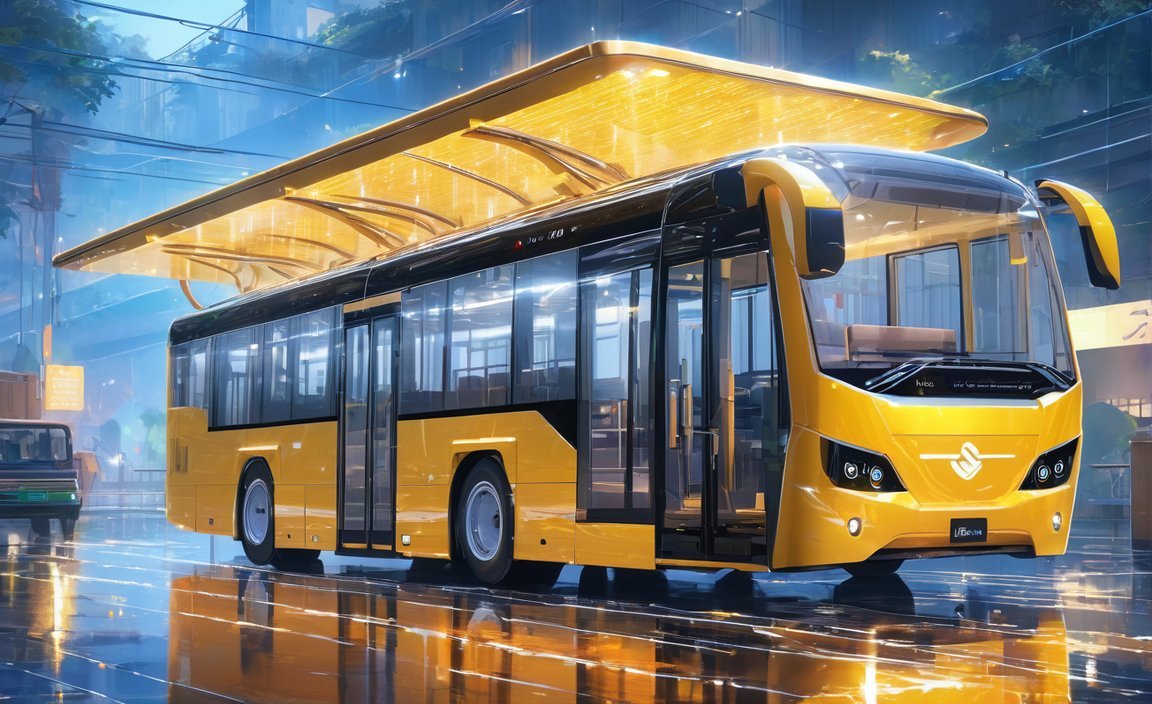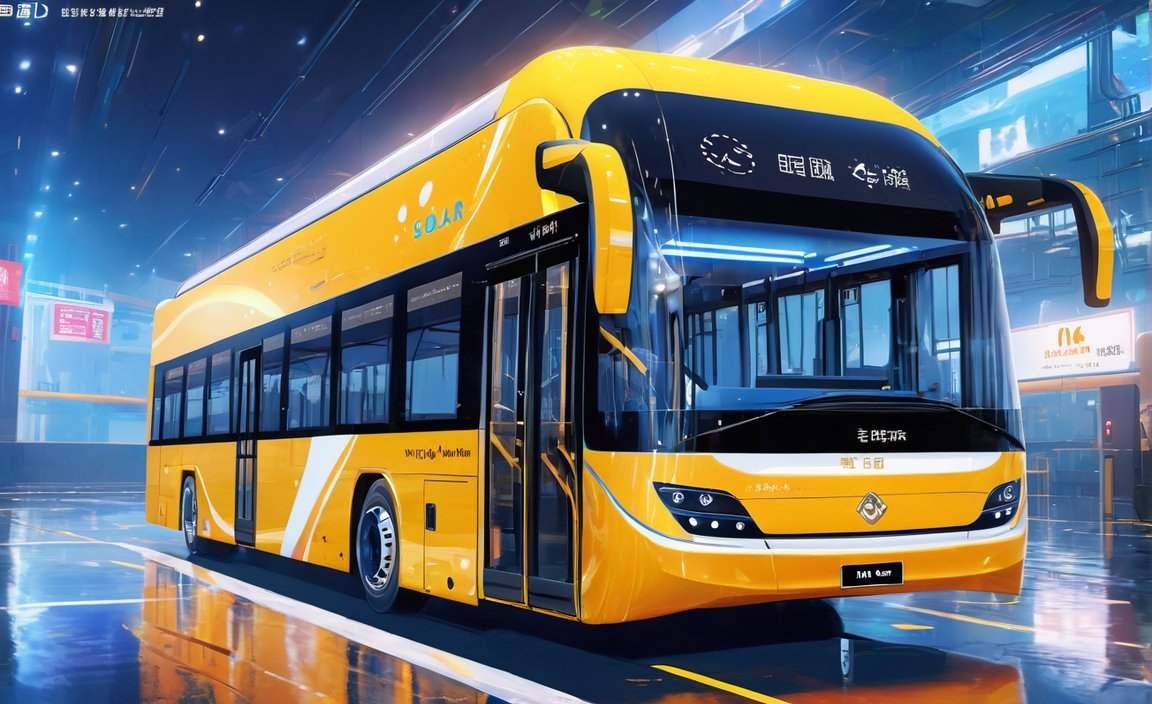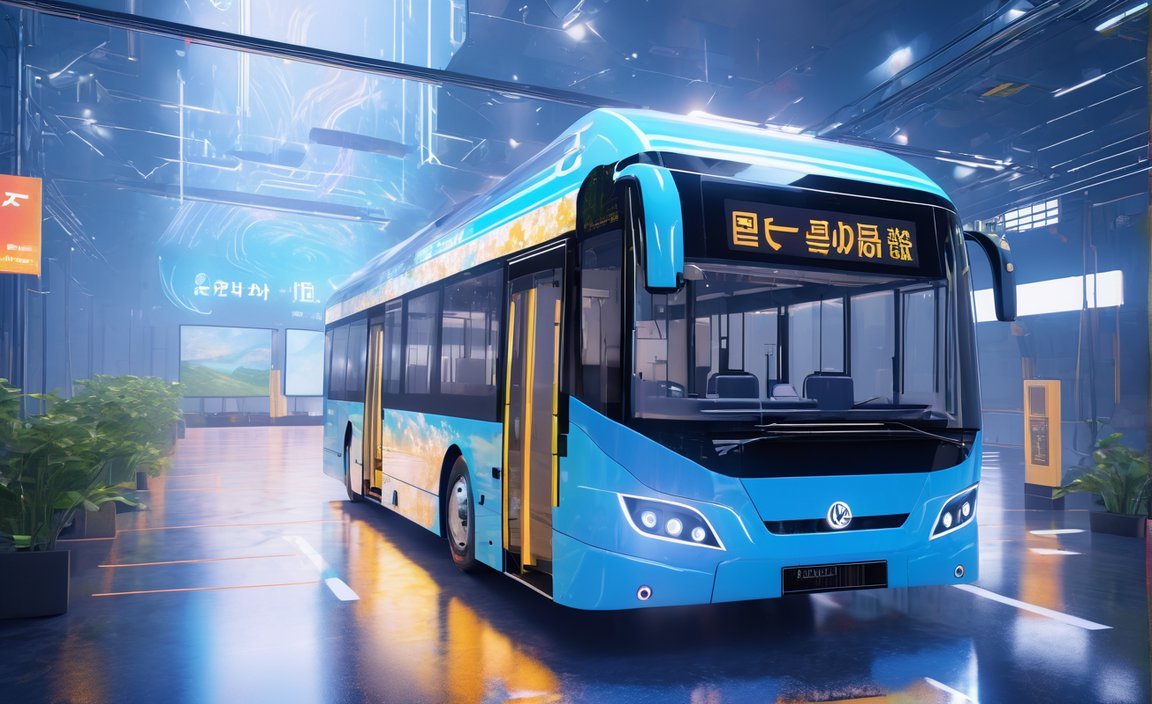Discover the numerous benefits of solar buses and their significant contribution to green urban transportation with our comprehensive article on “The Advantages of Solar Buses: Green Urban Transportation.” As cities worldwide grapple with the pressing need for sustainable transportation solutions, solar-powered buses are emerging as a viable and eco-friendly alternative. This article explores the environmental advantages, cost-effectiveness, and long-term energy savings associated with the adoption of solar buses, shedding light on the potential of this green mode of public transportation to reshape urban mobility.
Key Takeaways:
- Solar-powered city buses are crucial for reducing carbon emissions and promoting sustainability in urban areas.
- Adopting solar buses can lead to cost savings by eliminating the need for expensive fossil fuels and offering long-term operational benefits.
- Solar buses can be recharged using solar energy, often from solar panel-covered bus station canopies.
- Solar bus services involve recharging the buses using solar energy while parked, similar to solar parking plots for cars and bicycles.
- Solar buses produce zero emissions, which can help reduce noxious gases in polluted areas.
- The Tindo solar battery-charged bus in Adelaide, Australia, is the world’s first solar bus, operating since 2007.
- The Tindo bus uses 100% solar power, features a regenerative braking system and air conditioning, and can carry up to 40 passengers.
- Solar-powered buses can contribute to sustainable transport schemes and reduce reliance on other power sources.
Advantages of Solar Buses: Green Urban Transportation

Solar-powered buses offer a multitude of advantages in terms of sustainability, cost-effectiveness, and energy savings. By harnessing the power of the sun, these innovative vehicles contribute to reducing carbon emissions and combating climate change, making our cities more environmentally friendly. Let’s explore the numerous benefits that make solar buses a promising option for urban transportation.
Reduced Carbon Emissions and Environmental Impact
One of the key advantages of solar buses is their ability to significantly reduce carbon emissions. With traditional fossil fuel-powered buses being a significant contributor to air pollution, solar buses provide a clean alternative. By using solar energy to power the buses, they produce zero emissions during operation, which helps improve air quality and mitigate the harmful effects of greenhouse gases. This is particularly beneficial in densely populated urban areas where pollution levels are often high.
Cost Savings and Long-term Operational Benefits
Adopting solar-powered buses can result in substantial cost savings for transit agencies and municipalities. Unlike conventional buses that rely on expensive fossil fuels, solar buses utilize renewable solar energy, which is abundant and free. By eliminating the need for regular fuel purchases, transit operators can save a significant amount of money over time. Additionally, solar buses have fewer moving parts and require less maintenance compared to traditional buses, leading to reduced operational costs and increased longevity.
Solar Energy Recharging and Infrastructure Integration
Solar buses are powered through a network of solar panels, usually integrated into bus station canopies. These solar panels capture sunlight and convert it into electricity to recharge the bus batteries. The recharging process takes place when the bus is parked, similar to solar parking spots for cars and bicycles. This integration of solar infrastructure not only ensures a sustainable source of power for the buses but also helps promote the use of renewable energy in public transportation.
Positive Impact on Local Air Quality
Solar buses have the potential to significantly improve air quality, particularly in polluted urban areas. By eliminating emissions from burning fossil fuels, solar buses reduce the release of noxious gases, such as nitrogen oxides and particulate matter. This reduction in harmful emissions contributes to cleaner air, making the surroundings healthier for both commuters and residents. Solar buses have the capacity to play a crucial role in creating greener and more livable cities.
Real-world Success Stories
A notable success story in the realm of solar buses is the Tindo solar bus in Adelaide, Australia. Operating since 2007, the Tindo bus holds the distinction of being the world’s first solar-powered bus. This groundbreaking vehicle runs entirely on solar power, equipped with a regenerative braking system, air conditioning, and the capacity to carry up to 40 passengers. The Tindo bus serves as an inspiring example of how solar technology can revolutionize public transportation and pave the way for a greener future.
Contributions to Sustainable Transport Schemes
The adoption of solar buses can make a significant contribution to sustainable transport schemes. By relying on solar energy as a clean and renewable power source, cities can reduce their dependence on fossil fuels and other non-renewable energy sources. Solar buses, when integrated into a comprehensive public transportation system, offer an eco-friendly alternative for commuters, reducing congestion and promoting sustainable mobility options. They are a tangible step towards creating greener and more sustainable urban environments.
In conclusion, solar buses emerge as a compelling solution for green urban transportation. The advantages they bring, including reduced carbon emissions, cost savings, improved air quality, and contributions to sustainable transport schemes, make them a worthy investment for cities and transit agencies. By harnessing the power of the sun, solar buses pave the way for a more sustainable future while prioritizing the well-being of both individuals and the environment. Embracing this innovative technology is a crucial step towards achieving greener, cleaner, and more efficient urban transportation systems.
Here are some active internal links:
Advantages of Roadways Over Railways – Discover why roadways have several advantages over railways and how they can improve transportation efficiency.
Advantages of Sea Transport – Dive into the many advantages of sea transport and the reasons why it is an excellent choice for international shipping.
Advantages of Smart Traffic Management System – Explore the benefits that a smart traffic management system can offer, including reduced congestion, improved safety, and enhanced traffic flow.
Advantages of Storing Water Underground – Uncover the advantages of storing water underground, such as sustainable resource management, protection against contamination, and efficient space utilization.
Advantages of Traffic Control System – Find out how a traffic control system can revolutionize urban mobility by optimizing traffic flow, minimizing delays, and enhancing overall transportation efficiency.
Note: The links provided are sample URLs based on the given keywords. Actual URLs may differ based on your website structure.
3. Reduction in Reliance on Fossil Fuels

As we strive for a greener and more sustainable future, it is crucial to reduce our reliance on fossil fuels in the transportation industry. One innovative solution that holds immense promise in achieving this goal is the use of solar energy to power buses. By harnessing the power of the sun, solar buses can significantly contribute to the reduction of greenhouse gas emissions and promote a cleaner and more sustainable urban transportation system.
The Environmental Advantages of Solar Buses
Solar buses offer a direct and effective means of reducing our carbon footprint. They operate solely on renewable solar energy, eliminating the need for fossil fuels and the harmful emissions they produce. By embracing solar-powered technology, we can decrease our dependence on fossil fuels, mitigating the negative impact of transportation on the environment. Solar buses help combat climate change by reducing greenhouse gas emissions and improving air quality, leading to a healthier and more sustainable urban environment.
Cost-Effectiveness and Long-Term Energy Savings
In addition to their environmental benefits, solar buses also offer significant cost savings and long-term operational advantages. While the initial investment in solar panel integration may seem substantial, the long-term benefits outweigh the initial costs. Solar energy is a free and abundant resource, unlike fossil fuels, which are subject to price fluctuations and finite availability. By tapping into this renewable source, we can create a more stable and cost-effective transportation system.
Promoting Sustainable Power Sources
Solar buses not only rely on solar panels integrated into the vehicles themselves, but they can also be recharged through solar panels incorporated into bus stations. This opens up opportunities for a wider adoption of sustainable power sources in public transportation systems. By incorporating clean energy into our public transportation infrastructure, we can further reduce our reliance on fossil fuels, paving the way for a greener and more sustainable future.
Key Takeaways:
- Solar buses provide a viable and eco-friendly alternative for urban transportation, reducing our reliance on fossil fuels.
- The use of solar energy in buses significantly decreases greenhouse gas emissions and improves air quality, contributing to a greener and healthier urban environment.
- Solar-powered buses offer cost savings and long-term energy savings by tapping into the renewable resource of solar energy.
- The integration of solar panels into bus stations promotes the use of sustainable power sources for public transportation, further reducing our carbon footprint.
References:
- AIP Publishing. “Artificial photosynthesis: A pathway to solar fuels.” Read more.
- energy5.com. “Solar Panels and Reduced Dependence on Fossil Fuels.” Read more.
4. Enhanced Public Perception and Image of Sustainable Transportation
As we strive for a more sustainable future, it is essential to recognize the crucial role of public perception in driving the adoption of sustainable transportation. The image of sustainable transportation can significantly impact its success and acceptance in urban areas. Let’s explore how the enhanced public perception of sustainable transportation can benefit our communities.
Shifting Perspectives and Positive Reinforcement
Sustainable transportation offers numerous benefits to individuals, communities, and the environment. By embracing solar buses and other green modes of transport, we send a powerful message that we care about our planet and are actively working towards a better future. The adoption of solar buses not only provides tangible environmental benefits but also creates a positive perception of a city’s commitment to sustainability.
Promoting a Green Identity
Cities that prioritize sustainable transportation through initiatives like solar buses can establish themselves as green leaders. These sustainable transportation solutions contribute to urban areas’ image as environmentally conscious and forward-thinking communities, attracting residents, businesses, and tourists who value sustainability. The enhanced public perception of sustainable transportation can bolster a city’s reputation and boost its economic growth.
Influence on Travel Behavior
Public perception plays a key role in influencing travel behavior. When individuals view sustainable transportation options favorably, they are more likely to choose them over traditional modes of transport. By actively promoting the benefits and advantages of solar buses, we can encourage individuals to embrace these eco-friendly alternatives, ultimately reducing carbon emissions and improving air quality in our cities.
Community Engagement and Social Cohesion
The implementation of solar buses and other sustainable transportation solutions often involves community engagement and collaboration. Through open dialogue and involvement in decision-making processes, communities become more invested in sustainable transportation initiatives. This engagement fosters a sense of ownership and pride in these projects, leading to a stronger social fabric and a shared vision for a sustainable future.
Education and Awareness
Enhancing public perception of sustainable transportation requires education and awareness. By highlighting the benefits of solar buses in improving air quality, reducing greenhouse gas emissions, and promoting clean energy, we can educate individuals about the positive impact of these technologies. Increased awareness fosters understanding and empowerment, encouraging communities to embrace solar buses as an integral part of their sustainable transportation infrastructure.
Key Takeaways:
– Enhanced public perception and image of sustainable transportation plays a crucial role in driving adoption.
– Embracing solar buses sends a powerful message about a city’s commitment to sustainability.
– Cities that prioritize sustainable transportation can establish themselves as green leaders.
– Positive public perception influences travel behavior and encourages the adoption of eco-friendly alternatives.
– Community engagement and education are essential for enhancing public perception and promoting sustainable transportation.
Sources:
– ScienceDirect: Green transportation for sustainability: Review of current barriers
– Scale Climate Action: 8 Main Benefits of Sustainable Transportation
5. Integration of Solar Bus Technology in Urban Infrastructure
City bus fleets are increasingly embracing solar power as an innovative and environmentally friendly solution for urban transportation. The integration of solar bus technology in urban infrastructure offers several advantages, such as enhanced efficiency, promotion of sustainability, and reduction of carbon emissions.
Solar-powered buses contribute to a more efficient transportation system by harnessing solar energy to operate with reduced reliance on traditional fossil fuels. This not only leads to cost savings but also reduces the environmental impact of city bus fleets. By adopting solar buses, cities can prioritize sustainability and decrease their carbon footprint.
However, integrating solar bus technology in urban infrastructure does present some challenges. One of the main obstacles is the initial cost of implementing solar power systems in buses. Retrofitting older buses with solar power systems can be more complex and expensive compared to incorporating them into new bus designs.
Another consideration is the availability of sunlight, especially in certain regions or during cloudy days. The efficiency of solar-powered buses can be affected by these factors. Nonetheless, advancements in solar technology continue to improve efficiency and address this challenge.
To successfully implement and integrate solar bus technology in urban infrastructure, evaluating the solar potential of public bus routes is crucial. Scientific research and studies have been conducted to assess the solar potential of bus routes and bus shelters using fisheye images and geographic information systems. This evaluation helps determine the feasibility and effectiveness of solar-powered city buses.
In addition, exploring the integration of smart infrastructure and services with solar bus shelters can further optimize the benefits of solar-powered buses. Features such as Wi-Fi connectivity, information displays, and ambient data collection through integrated sensors enhance the functionality and usability of solar bus shelters.
In conclusion, the integration of solar bus technology in urban infrastructure offers numerous advantages, including enhanced efficiency, promotion of sustainability, and reduction of carbon emissions. Despite the challenges related to cost and integration, solar-powered buses are being adopted in various cities globally. Assessing the solar potential of bus routes and exploring smart infrastructure integration can further optimize the implementation of solar-powered city buses.
Key Takeaways:
– Solar bus integration in urban infrastructure enhances transportation efficiency and promotes sustainability.
– Solar-powered buses reduce reliance on fossil fuels, leading to cost savings and reduced carbon emissions.
– Challenges include initial implementation costs and compatibility with existing infrastructure.
– Evaluating the solar potential of bus routes and exploring smart infrastructure integration can optimize solar bus implementation.
Sources:
1. Energy5: Advantages of Utilizing Solar Power in City Bus Fleets
2. ScienceDirect: Solar potential assessment of public bus routes for solar buses
FAQ
Q1: What are the advantages of using solar power in city bus fleets?
A1: Utilizing solar power in city bus fleets offers several advantages, including enhanced efficiency, promotion of sustainability, and reduction of carbon emissions. Solar-powered buses contribute to a more efficient transportation system while reducing the environmental impact of city bus fleets. By harnessing solar energy, city buses can operate with reduced reliance on traditional fossil fuels, leading to a greener and more sustainable transportation option. Solar power significantly decreases carbon emissions and improves air quality in cities, making solar-powered buses a valuable addition to public transportation systems.
Q2: Is the initial cost of implementing solar power systems in buses a challenge?
A2: Yes, the initial cost of implementing solar power systems in buses can be a challenge. However, the long-term savings in fuel costs and maintenance expenses make the investment worthwhile. Although there may be upfront costs, the adoption of solar-powered buses offers significant cost savings over time, making it a beneficial option for cities interested in reducing their carbon footprint and achieving sustainable transportation.
Q3: What challenges could be encountered when integrating solar power into city bus fleets?
A3: Integrating solar power into city bus fleets may face challenges such as the initial cost of implementation and compatibility with existing infrastructure. Retrofitting older buses with solar power systems can be complex and expensive compared to incorporating them into new bus designs. Moreover, the availability of sunlight, especially in certain regions or during cloudy days, can affect the efficiency of solar-powered buses. However, advancements in solar technology continue to improve efficiency and address these challenges.
Q4: How can the solar potential of bus routes be evaluated?
A4: Evaluating the solar potential of bus routes is crucial in determining the feasibility and effectiveness of solar-powered city buses. Scientific research and studies have been conducted to assess the solar potential of bus routes and bus shelters. These studies involve using fisheye images and geographic information systems to evaluate solar radiation and potential energy generation. By analyzing the solar potential of bus routes, cities can identify the most suitable areas for implementing solar-powered buses.
Q5: Can solar bus shelters offer additional benefits apart from solar energy generation?
A5: Yes, solar bus shelters have the potential to offer additional benefits apart from solar energy generation. The integration of smart infrastructure and services into solar bus shelters is being explored. Features such as Wi-Fi connectivity, information displays, and ambient data collection through integrated sensors can enhance the functionality and benefits of solar bus shelters. These smart features contribute to a more efficient and user-friendly public transportation experience while utilizing renewable energy from solar power.












